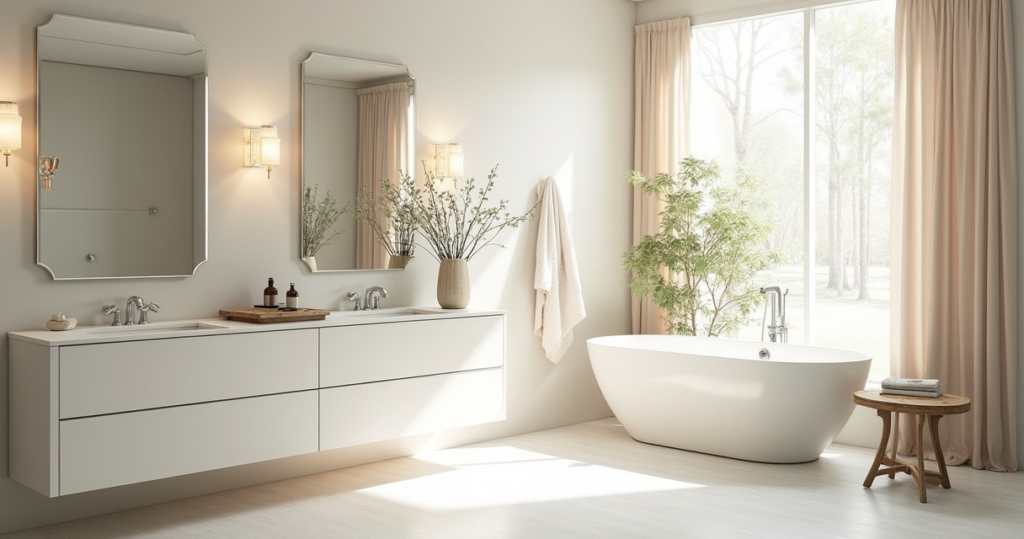When you step into your bathroom, what story does it tell? Is it a purely functional, forgotten corner of your home, or is it a space that genuinely restores you? I believe this room, more than any other, is a sanctuary for our most private daily rituals—the place we begin our day and the last space we inhabit before sleep. It deserves to be more than just functional; it deserves to be meaningful.
Drawing from my own Polish-Chinese heritage, I’ve spent my life navigating the beautiful space between different worlds. It’s taught me that the best design isn’t about choosing one culture over another, but about weaving them together into a personal tapestry. A bathroom can be a place of quiet, Japanese-inspired contemplation (shizukesa) and also embody the cozy, life-affirming warmth of Slavic hospitality. It’s not about trends; it’s about crafting a space that holds and honors your own unique story.
Whether you’re working with a tiny powder room or planning a grand master suite, let’s walk through how to create a bathroom that feels both globally sophisticated and deeply, authentically yours.
1. Start with Soul-Searching, Not Just Style-Boarding
Before you fall in love with a single tile or faucet, the most important work happens. It’s a quiet observation of your own life. Too often, we tear out pages from magazines showing vast, sun-drenched bathrooms with freestanding tubs, only to realize our reality is two adults and a toddler trying to get through the morning rush in 60 square feet. The most successful remodels I’ve seen began with this kind of raw honesty.

I once had clients, a young couple, who were convinced they needed a massive, spa-like tub. But after I had them journal their bathroom use for just one week, they had a revelation. The tub would be used maybe twice a year. What they were really desperate for was more counter space and hyper-organized drawers to stop the daily arguments over a single sink. They needed a place of peace, not a place for performance. So, what do you really need?
- Conduct a truth audit: For one week, just notice. Where are the bottlenecks? When do you feel most frustrated or most at peace in the space?
- Interview your household: Ask everyone—partners, kids, even frequent guests—what their biggest pet peeve is about the current bathroom. You’ll be surprised by what you hear.
- Map out your stuff: Empty all your cabinets and drawers. What do you actually use? What needs a home? This isn’t just about storage; it’s about making your daily routine feel effortless.
- Look to the future: Will this home be where you age? Could your family grow? Thinking about grab bars or a curbless shower now is smart, not morbid.
Once you know your “why,” every other decision becomes simpler and far more meaningful.
From this foundation of self-knowledge, we can begin to shape the physical space.
2. Master the Art of Flow and Layout
In a small bathroom, every inch has to work hard. The goal isn’t just to cram fixtures in; it’s to create a feeling of ease and openness. I often draw on the spatial intelligence I’ve observed in traditional Japanese homes, where there’s an elegant dance between elements and nothing is superfluous. It’s about creating clever sightlines and paths that trick the eye into seeing more space than there is.

Wall-mounted or “floating” vanities and toilets are brilliant for this. By lifting everything off the ground, you let the flooring extend all the way to the wall, instantly making the room feel wider. Another game-changer? Pocket doors. They slide into the wall instead of swinging into the room, magically gifting you back nearly nine square feet of usable space. Think about that. That’s a huge win in a tight spot.
Corner sinks can be another unsung hero. We’re so conditioned to see vanities flat against a wall, but tucking one into a corner can open up the layout in surprising ways, improving the flow of traffic and freeing up precious wall space for a taller storage cabinet.
This is where you move from just placing objects to choreographing a space that feels intuitive and graceful to move through.
Once you have the flow, you can place the largest and most sculptural element: the tub.
3. The Great Tub Debate: Freestanding vs. Built-in
This is one of the biggest forks in the road for any bathroom project. It really gets to the heart of the tension between the aesthetic we aspire to and the life we actually live. In the West, we often see the bath as a luxurious, occasional escape. In other cultures, like in Japan with its ofuro tradition, it’s a more frequent, almost spiritual ritual of cleansing and release.

There’s no denying it: a freestanding tub is a showstopper. It acts as a beautiful piece of sculpture in the middle of your room. But you have to be brutally honest with yourself. Are you prepared for the reality of cleaning behind it and under it? That gap becomes a magnet for dust and hair. And the exposed plumbing, while stylish, can add complexity and cost to the installation.
A built-in tub, on the other hand, is the practical workhorse. Integrated with a shower, it’s a master of functionality, especially for families. It also gives you a canvas—the tiled surround—where you can express yourself, and a practical ledge for shampoo, candles, or a glass of wine. For many homes, this is simply the more sensible choice.
- Be honest about your habits: How many baths did you actually take last year?
- Get out the measuring tape: Freestanding tubs need breathing room. You need at least a foot of clearance all around to make cleaning manageable.
- Factor in the ‘annoyance cost’: Is the beauty of the tub worth the frustration of fishing a dropped soap bar from behind it?
The right answer lies in finding the balance that honors both your dream of a sanctuary and the reality of your Tuesday morning.
If your reality leans more toward daily showers, that opens up a whole new world of design possibilities.
4. Designing a Walk-in Shower: Beyond the Barrier
The walk-in, curbless shower is one of my favorite modern bathroom features because it’s a perfect fusion of minimalist aesthetics and inclusive, universal design. Getting rid of the curb—that small step up—does more than just create a sleek, unbroken line. It makes the space accessible to everyone, regardless of age or mobility. It’s the kind of design I deeply admire, where beauty and care for others become one and the same.
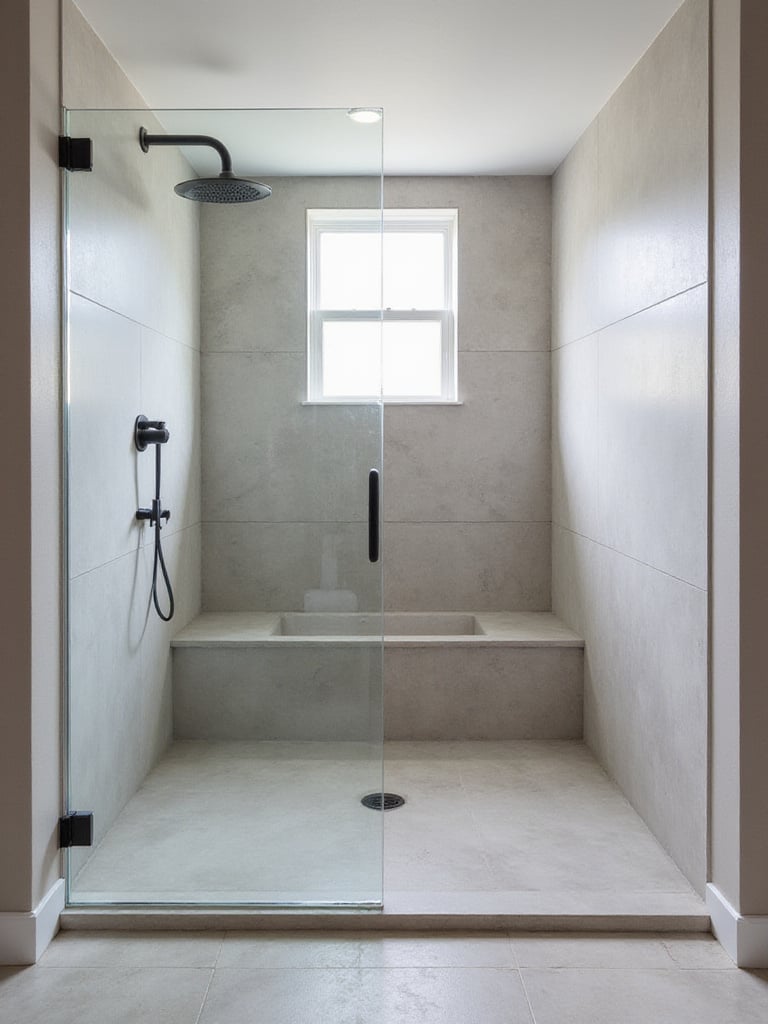
Now, this is where the technical details are crucial. A curbless shower is not a DIY-weekend project. The entire bathroom floor essentially becomes a sophisticated drainage system. You need an expert who understands waterproofing membranes and how to create the perfect, subtle slope toward the drain to prevent pooling. A linear drain, which looks like a sleek metal slot, is often the best choice here, as it allows the floor to slope gently in just one direction.
Freed from being a box in the corner, the shower becomes an integral part of the room’s architecture. This is your chance to make a statement. I’ve seen clients use a dramatic, large-format slab of stone on the back wall, or carry a beautiful floor tile right up the shower wall for a seamless, expansive feel. The shower is no longer just a place to get clean; it’s a design experience.
- Don’t skimp on drainage: Insist on a proper slope (at least 1/4 inch per foot) and high-quality waterproofing. This is the foundation of the whole design.
- Invest in good glass: Coatings that resist water spots are worth every penny and will save you endless hours of squeegeeing.
- Plan for comfort: Even if you don’t need it now, ask your contractor to add wood blocking inside the walls where a bench or grab bar could be installed later. It’s an easy, inexpensive step during construction that’s a nightmare to add later.
Just outside the shower is the bathroom’s other major hub of activity.
5. The Vanity: Your Bathroom’s Hardest-Working Feature
The vanity is the command center of the bathroom. It’s where grooming rituals unfold, and it’s where the need for calm and the need for stuff collide head-on. The vanity you choose says a lot about your household—it’s a surprisingly intimate piece of furniture.

Floating vanities are fantastic for creating that sense of lightness and space, especially in smaller bathrooms. But be aware, they require proper structural support in the wall. The benefit is an easy-to-clean floor and a very modern, airy look. On the other hand, a traditional floor-mounted vanity is the king of storage, offering deep drawers and generous cabinet space that a floating version just can’t match. For a busy family, that extra storage might be non-negotiable.
And then there’s the great single vs. double sink debate. This isn’t just a practical question; it can be a relationship question! Two sinks can be a marriage-saver in the mornings, but they eat up valuable counter space. Really think about how your mornings unfold. Do you truly need to be at the sink at the same time, or would one of you be happier with more space for makeup and toiletries?
Don’t forget the countertop material. Quartz is the low-maintenance hero, consistent and nearly indestructible. Natural stone like marble is breathtakingly beautiful but requires more care and will develop a patina over time—a story of its use that some, myself included, find beautiful. And a final tip: ask your electrician to install an outlet inside a drawer. It’s a small change that keeps your counters beautifully clear of charging toothbrushes and shavers.
From the vanity, let’s turn our attention to a fixture that’s undergoing a quiet revolution.
6. The Modern Throne: More Than Just a Toilet
It’s fascinating to watch how technology is transforming one of the home’s most basic fixtures. As someone who navigates Eastern and Western design, I find it particularly interesting to see features that have been standard in Japan for decades—like integrated bidets and heated seats—finally making their way into the Western bathroom. We’re starting to see the toilet not just as a utility, but as an opportunity for improved hygiene and comfort.

Water efficiency is, thankfully, now a given. High-efficiency toilets with dual-flush systems are an easy win for both the environment and your water bill. Look for the WaterSense label, which certifies that the fixture uses at least 20% less water than the federal standard without sacrificing performance. Frankly, there’s no good reason to install a non-efficient model anymore.
The “smart” features are where it gets personal. A heated seat might sound like an absurd luxury, until you experience it on a cold winter morning. An integrated bidet or washlet offers a level of cleanliness that toilet paper alone can’t match. For people with mobility issues, these features aren’t just about comfort; they’re about dignity and independence.
- Look for rebates: Many cities offer financial incentives for installing WaterSense fixtures. Check your local utility’s website.
- Plan for power: These smart features need electricity, so you’ll need a GFCI-protected outlet installed near the toilet during the rough-in phase.
- Test drive if you can: High-end plumbing showrooms often have working models. It might feel awkward, but it’s the only way to know if these features are right for you.
With the fixtures chosen, we need a solid, beautiful surface to stand on.
7. A Foundation of Style: Choosing Durable Flooring
Bathroom flooring has to be a warrior. It faces daily onslaughts of water, steam, and humidity that would ruin floors in any other part of the house. Your choice here is a critical balance between the look you want today and the performance you’ll need for the next twenty years. A beautiful floor that fails is a costly, heartbreaking mistake.

Porcelain tile is the undisputed champion of the bathroom. It’s virtually waterproof (look for a water absorption rate of less than 0.5%), incredibly tough, and thanks to modern printing technology, it can convincingly mimic almost any material—wood, marble, concrete, you name it. A little insider tip: using large-format tiles (like 24×24 inches or even larger) means fewer grout lines. This not only creates a more seamless, expansive look but also means less grout to scrub.
Natural stone is a love affair. It’s undeniably gorgeous and connects your modern bathroom to geologic time. But it’s a higher-maintenance relationship. Softer stones like marble and limestone need to be sealed regularly to resist staining and water damage. Harder stones like slate and granite are more forgiving, but still require proper care.
But here’s the most important part, the secret that designers know: the best tile in the world will fail if the subfloor isn’t prepared properly. The waterproofing, the backer board, the right type of mortar—that invisible infrastructure is what guarantees your beautiful floor will last.
Building up from that solid foundation, the walls are your next opportunity for expression.
8. Walls as Your Canvas: The Power of Tile
Tiling your walls is about so much more than just waterproofing. Your walls are a canvas, an opportunity to infuse the space with personality, art, and cultural meaning. This is where you can tell a story. You could choose the glossy, imperfect beauty of Moroccan zellige tiles, the clean geometry of patterns inspired by Islamic art, or even subtle textures that evoke the tranquility of a Japanese rock garden.

The application is just as important as the tile itself. An accent wall behind the vanity or in the shower can create a powerful focal point. Tiling all the way to the ceiling can make the room feel taller and more grand. The interplay of finishes—matte next to glossy, smooth against textured—adds a layer of sophistication that makes a space feel truly custom and intentional.
One of my favorite techniques is to use a simple, affordable field tile for most of the space, and then splurge on a small amount of a truly special, handmade tile for a feature niche in the shower or a “backsplash” behind the vanity. It’s a way to get a huge design impact without breaking the budget.
- Plan the layout meticulously: A good tile setter will start from the center of the wall and work outwards to ensure the pattern is balanced and you don’t end up with awkward, skinny little tile slivers in the corners.
- Don’t forget the grout: Grout color dramatically changes the final look. A contrasting grout emphasizes the pattern of the tiles, while a matching grout creates a more subtle, monolithic look.
- Think about touch: Textured tiles are wonderful for adding depth, but be aware that they can be a bit trickier to wipe down in a shower setting.
The most beautiful tile in the world will fall flat, however, if it’s not lit properly.
9. Layered Light: Crafting Mood and Function
Lighting in a bathroom is a delicate science. It has to be ruthlessly functional for tasks like shaving or applying makeup, but also able to shift to a soft, ambient glow for a relaxing bath. A single, harsh overhead light is the enemy of a good bathroom. It casts unflattering shadows and makes everyone look tired. The key is to think in layers: ambient, task, and accent.

Task lighting is the most critical. This is the light around your vanity mirror. The best possible setup is to have lights on either side of the mirror at face-level, like sconces. This cross-illumination erases shadows and provides clean, even light. If you can’t do sconces, a backlit mirror is an excellent alternative. Pay attention to the light’s color temperature—look for bulbs in the 2700K to 3000K range for a warm, flattering light that’s close to natural daylight.
Ambient lighting is your general, overall illumination. This can come from recessed ceiling lights on a dimmer switch. Dimmer switches are non-negotiable in a bathroom; they allow one set of lights to go from bright and energizing in the morning to soft and calming at night.
Accent lighting is the jewelry. A small spotlight on a piece of art, LED strip lighting in a shower niche or under a floating vanity—these are the little details that make a design feel custom and luxurious. They create depth and draw the eye, turning a simple room into a sophisticated space. Smart controls that allow you to set “scenes” (like “Morning Prep” or “Evening Unwind”) are the final touch, letting you change the entire mood of the room with a single button press.
Now that we can see everything clearly, let’s figure out where to put it all.
10. The Art of Concealment: Next-Level Storage
Clutter is the enemy of calm. In a bathroom, where we accumulate an endless array of bottles, tubes, and tools, smart storage is the key to maintaining a sense of sanctuary. The best solutions don’t just add a bulky cabinet; they integrate storage into the very architecture of the room.
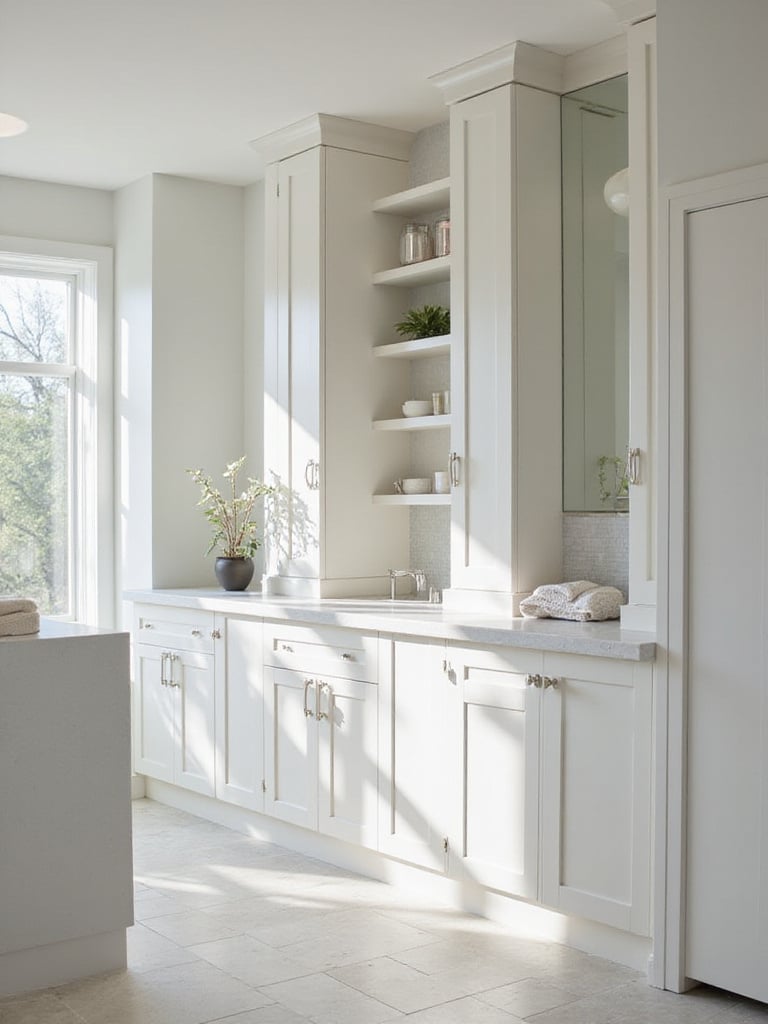
Shower niches are a perfect example. A niche built into the wall cavity of your shower is so much more elegant than a rusty shower caddy hanging from the showerhead. Think carefully about the height—make them tall enough for those oversized shampoo bottles! I often recommend designing two or three smaller niches at different heights rather than one giant one; it allows for better organization and looks more visually interesting.
The humble medicine cabinet has also had a major upgrade. A recessed model sits flush with the wall, providing hidden storage without protruding into your space. You can now find versions with integrated electrical outlets for charging, interior lighting, and even defogging pads that keep the mirror clear after a steamy shower. They are stealthy, hardworking marvels.
- Audit your items again: This time, sort them by frequency of use. Everyday items need to be at your fingertips. Weekly-use or backup items can go in higher or lower storage.
- Electrify your storage: Plan for outlets inside your vanity drawers and medicine cabinet. It’s a game-changer.
- Think vertically: In small bathrooms, a tall, narrow linen tower can provide a huge amount of storage while taking up a tiny footprint.
Great storage is a must, but it’s useless if the room itself is damp and musty.
11. Breathe Easy: The Unsung Hero of the Bathroom
Let’s talk about something that isn’t glamorous but is absolutely essential: ventilation. A powerful, quiet exhaust fan is the silent guardian of your investment. It pulls moisture-laden air out of the room, preventing the growth of mold and mildew, stopping paint from peeling, and protecting your cabinetry from warping over time. Ignoring ventilation is one of the most expensive mistakes you can make.

Sizing and placement are key. The fan should be sized appropriately for the square footage of your room and, ideally, placed directly over the shower or tub, where it can capture steam at the source. And please, make sure it’s actually ducted to the outside of your house, not just into the attic space (a common and dangerous shortcut).
The problem is, if a fan is loud and obnoxious, people won’t use it. Modern fans are remarkably quiet. Look for models with a low “sone” rating (1.0 or less is considered very quiet). Many now come with features like humidity sensors that automatically turn the fan on when things get steamy and off when the air is clear. This is brilliant because it works whether you remember to flip the switch or not.
Think of your vent fan as a health and preservation system. It’s not an optional extra; it’s the lungs of your bathroom, ensuring it stays healthy and beautiful for years.
This same mindset of health and well-being should apply to the very materials you choose.
12. Healthy Materials for a Healthy Home
We are becoming increasingly aware of how our indoor environments affect our health. Because a bathroom is a small, enclosed space, the materials you choose have a significant impact on its air quality. The adhesives, paints, and finishes used can “off-gas” volatile organic compounds (VOCs) for years, which isn’t great for anyone, especially people with sensitivities or allergies.

The good news is that choosing healthier materials has never been easier. Look for paints, primers, and sealants that are labeled “low-VOC” or “zero-VOC.” Certifications like GREENGUARD Gold are a reliable way to know that a product has been tested and meets strict chemical emission limits. It’s not about being a purist; it’s about making simple swaps that create a healthier sanctuary for you and your family.
Of course, sustainability also means conserving resources. This goes back to our fixture choices. Installing WaterSense certified faucets, showerheads, and toilets is one of the most effective ways to reduce your home’s environmental footprint and lower your utility bills. It’s a choice that feels good on every level.
- Ask your contractor about local recycling: Old toilets, sinks, and tile can often be recycled or donated instead of ending up in a landfill.
- Think long-term: Choosing durable, timeless materials means you won’t need to renovate again in ten years, which is the most sustainable choice of all.
- Look for renewables: Materials like bamboo (a fast-growing grass) for cabinetry or cork for flooring (in a powder room, not a full bath) are beautiful and eco-conscious options.
Creating a healthy home also means creating a home that can adapt to our needs over a lifetime.
13. Design for a Lifetime: The Grace of Accessibility
Universal design is one of the most thoughtful movements in our field. It’s about creating spaces that are comfortable and usable for everyone, regardless of their age or physical ability. And here’s the secret: when done well, it’s completely invisible. It’s just good design that feels better for everyone.
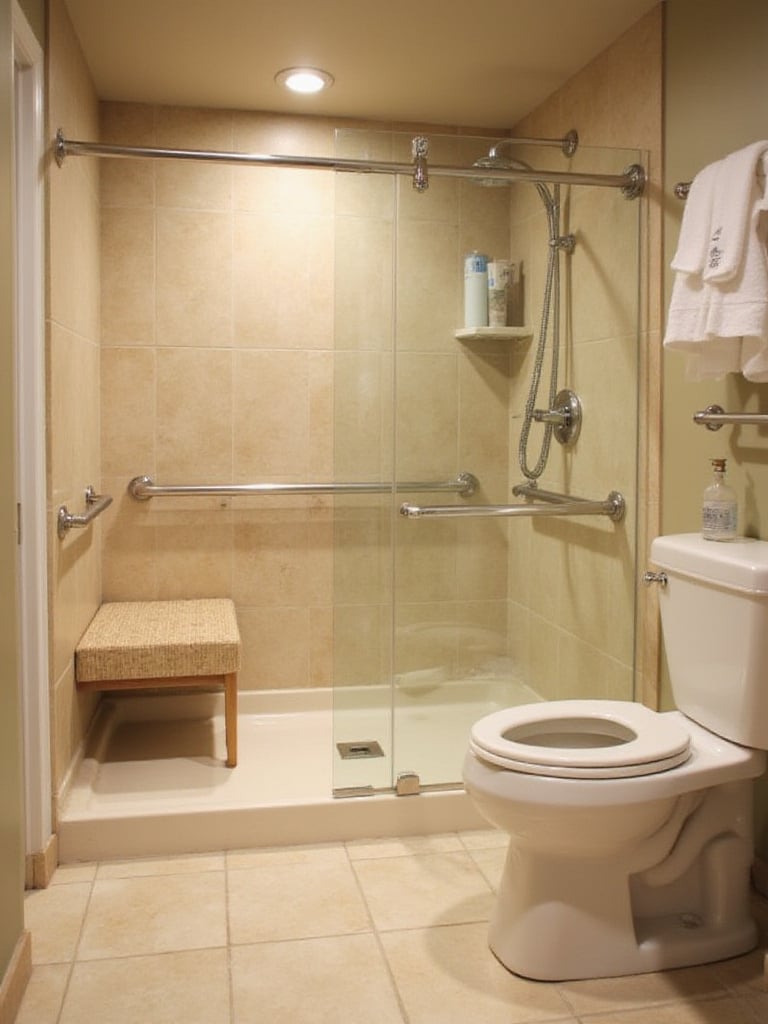
That curbless shower we talked about? That’s a cornerstone of universal design. So is a “comfort height” toilet, which is a couple of inches taller and easier to get on and off of for people with bad knees (which, let’s be honest, is many of us). Lever-style door handles and faucets are easier to operate with wet or soapy hands than round knobs.
This is another area where planning ahead during a remodel pays huge dividends. The most important thing you can do is add “blocking”—simply pieces of plywood installed between the wall studs—in strategic locations before the drywall goes up. You can put it next to the toilet, inside the shower, and near the tub entrance. You don’t have to install grab bars now, but if you or a family member ever need them, the reinforcement is already there, waiting. It’s an easy, inexpensive piece of foresight that can make all the difference in allowing someone to stay in their home safely and with dignity.
Investing in these thoughtful features is about creating a home that takes care of you, now and in the future.
Part of that long-term care comes from investing in the quality of the things you touch every single day.
14. An Investment in Touch: Selecting High-Quality Fixtures
Your faucets, shower controls, and toilet handle are the parts of your bathroom you will physically interact with multiple times, every single day, for years. This is not the place to skimp. The difference between a cheap faucet and a quality one is often hidden inside, but you’ll feel it in the long run.
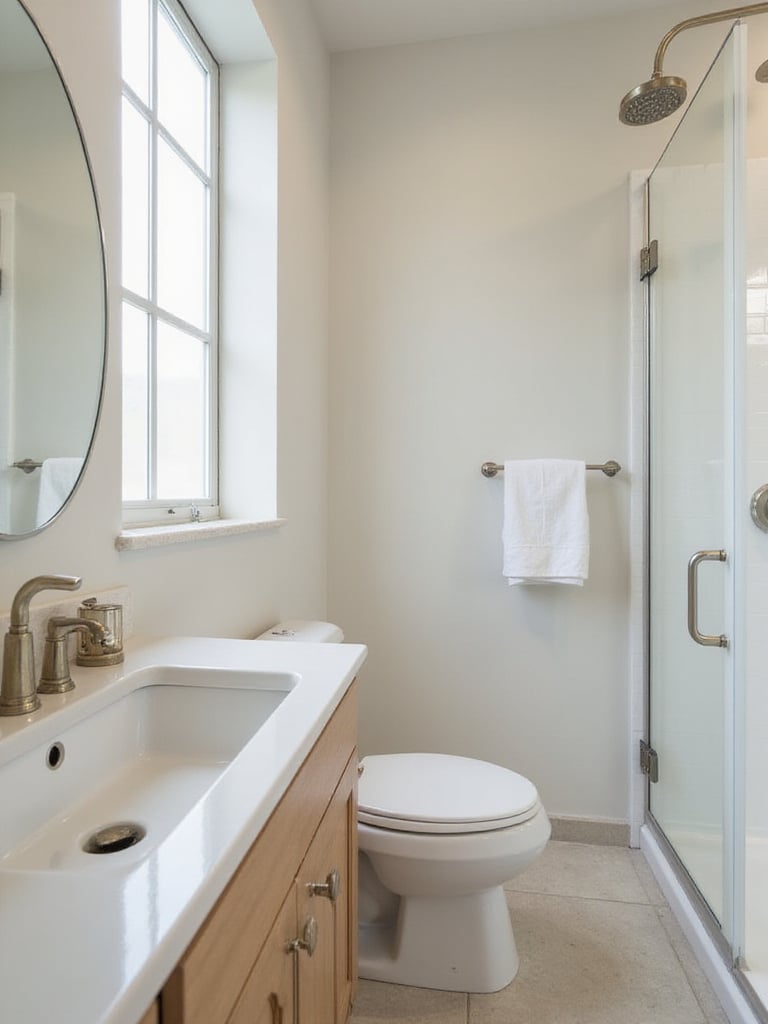
High-quality faucets are typically made of solid brass, not plastic or zinc, which means they are far more durable. They use ceramic disc valves instead of rubber washers, which provides a lifetime of smooth, leak-free operation. The finish on a quality fixture is thicker and more resilient, so it won’t peel or corrode after a few years of being cleaned. A good warranty is often the best indicator of a manufacturer’s confidence in their product.
When it comes to toilets, performance is paramount. No one wants a “high-efficiency” toilet that you have to flush three times. The industry has an independent testing protocol called a MaP (Maximum Performance) score, which tells you how much solid waste a toilet can remove in a single flush. It’s an objective measure that helps you cut through the marketing jargon and choose a toilet that actually works.
- Look for the certifications: WaterSense, ADA compliance, and high MaP scores are your friends.
- Lift it: In the showroom, literally feel the weight of a faucet. A heavier fixture often indicates better materials inside.
- Read the warranty: A lifetime warranty on the finish and function is a very good sign.
Beyond the man-made fixtures, bringing in elements from the natural world adds a unique and vital layer to the space.
15. Speaking Nature’s Language with Wood and Stone
Bringing natural materials into the bathroom connects our most personal rituals to the wider world. There’s a grounding, calming effect to wood and stone that synthetic materials just can’t replicate. It’s a core principle of biophilic design—the idea that humans have an innate need to connect with nature, and that doing so is good for our well-being.

Of course, a bathroom is a harsh environment for natural materials. You have to choose wisely. For wood, that means naturally water-resistant species like teak, ipe, or even thermally modified woods. I’ve used slatted teak for shower floors or bathmats, and it brings such an incredible warmth and spa-like feel. All wood in a bathroom must be properly sealed and the room must be well-ventilated, but it can be done beautifully.
With stone, you are bringing millions of years of geologic history into your home. Each piece is unique. Again, it’s about choosing the right stone for the job. Granite and slate are tough and less porous, making them great choices. Marble and travertine are softer and more absorbent, so they will show water spots and develop a patina over time. You have to embrace this as part of their character, a living finish that records the history of your home. It’s a very wabi-sabi approach—finding beauty in the imperfection and impermanence.
- Ask about sealing: Understand the maintenance commitment before you fall in love with a porous stone.
- Embrace patina: If you choose a material like marble or unlacquered brass, be prepared for it to change over time. It’s not a flaw; it’s its nature.
- Mix your textures: The coolness of a stone countertop paired with the warmth of a wooden vanity is a classic and beautiful combination that engages multiple senses.
The colors of these natural materials can serve as the starting point for the room’s entire palette.
16. Painting with Emotion: Your Color Palette
Color is one of the most powerful and personal tools in design. In a bathroom, a small, enclosed space, its effect is intensified. Your color palette sets the emotional tone, creating a space that can be invigorating and fresh, or serene and womb-like.
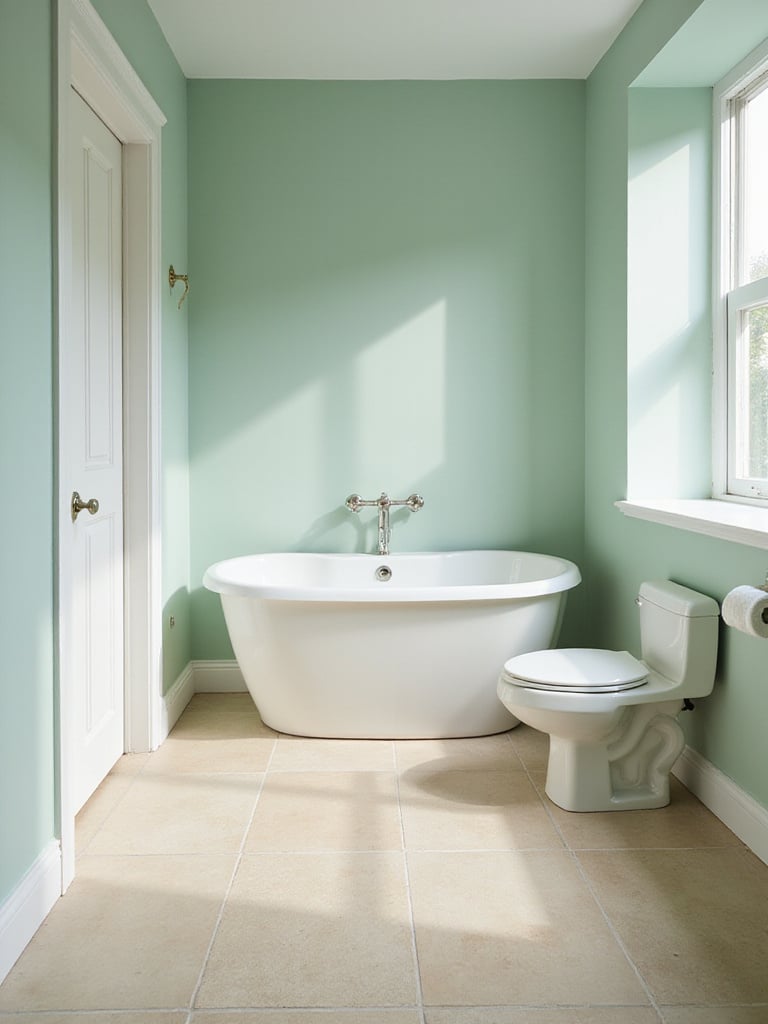
Monochromatic palettes—using varying shades and tints of a single color—are incredibly sophisticated and calming. Think of all the shades of a misty grey-green or a warm, sandy beige. The interest comes not from contrasting colors, but from contrasting textures: a smooth painted wall, a glossy tile, a matte countertop, a linen towel. This approach is wonderful for making small spaces feel larger and more cohesive.
Neutral palettes are timeless and provide a flexible backdrop for accessories that you can change out with the seasons—towels, a bathmat, a piece of art. The key to a great neutral room is to mix warm neutrals (like cream and beige) with cool neutrals (like grey and white) to create a dynamic, layered look that avoids feeling flat or sterile.
And remember that color has cultural weight. Blues and greens are almost universally associated with water and nature, making them a natural fit for a bathroom. Earth tones can create a grounded, nurturing feeling. I always urge clients to think about the colors from their own heritage or travels that bring them joy. A particular shade of terracotta might remind you of a trip to Tuscany, while a deep indigo might connect to a Japanese textile you love.
Always, always test paint colors in the bathroom itself. The way the light hits in that specific room, both natural and artificial, will dramatically change how a color looks and feels.
Imagine that beautiful color on a floor that’s also blissfully warm to the touch.
17. The Secret Luxury: Radiant Floor Heating
This is one of those “invisible” upgrades that delivers an incredible amount of daily pleasure. Radiant floor heating turns what is often the coldest surface in your home into a source of gentle, consistent warmth. Stepping out of the shower onto a heated tile floor on a chilly morning is a simple, profound luxury. It’s the very definition of the Danish concept of hygge—a feeling of cozy contentment.

The system works beautifully with tile and stone, as these materials are excellent thermal conductors. Thin electric mats are installed directly under the flooring, so they don’t significantly raise the floor’s height, making them perfect for remodels. A programmable thermostat allows you to be smart about it—you can set the floors to warm up just before you wake up and turn off when you leave for the day, so you get all the comfort with minimal energy waste.
Honestly, in all my years of design, I have never had a single client regret installing heated floors. It’s one of those things that, once you experience it, you can’t imagine living without. It transforms the feeling of the entire room, making it feel cared for and deeply comfortable.
- Insulate below: Make sure your contractor installs proper insulation under the subfloor, so all that lovely heat radiates up into your room, not down into the crawlspace.
- Plan the zones: You can create different heating zones. Maybe you only want the area right in front of the vanity and shower heated, which can save on installation and running costs.
- Get a dedicated circuit: These systems require their own GFCI-protected electrical circuit to operate safely.
From unseen heating to seen technology, it’s wise to plan for the future.
18. Future-Proofing Your Sanctuary
Technology is weaving itself into every corner of our homes, and the bathroom is no exception. The challenge is to integrate it thoughtfully, planning for what’s coming without installing gadgets that will feel dated in five years. The key is to focus on the infrastructure, not the specific device.
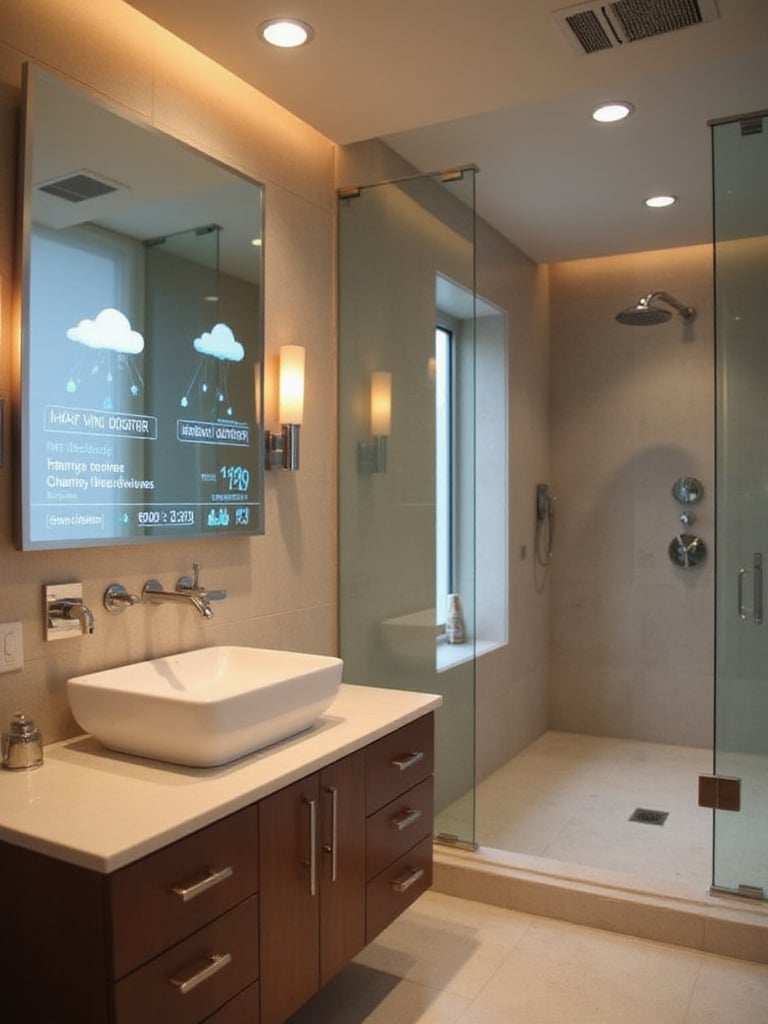
This means planning for power and connectivity in smart places. A smart mirror that can display the weather, your calendar, or even control the lights is a great feature. But for it to work, you need an electrical outlet placed correctly behind it. An advanced digital shower system that lets each family member program their perfect temperature and spray pattern is fantastic, but it requires both complex plumbing and electrical work that has to be planned from the very beginning.
My best advice is to run more power than you think you’ll need. Have your electrician run an extra circuit to the bathroom. Place outlets in discreet locations, like inside the vanity or in a linen closet. The goal is to create a flexible backbone that can support the technologies of tomorrow, whatever they may be.
Now, for the final, crucial step: making it all happen without financial stress.
19. The Reality Check: Budgeting with Wisdom
A well-planned budget is not a restriction; it’s a tool of empowerment. It allows you to make clear, confident decisions and ensures your dream remodel doesn’t turn into a financial nightmare. A successful project is one that you love not just on the day it’s finished, but also on the day the final bill is paid.

The most important rule: plan for the unexpected. When you open up walls in an older home, you will almost certainly find something you weren’t expecting—old plumbing, outdated wiring, or hidden water damage. A contingency fund of 15-20% of your total budget is not optional. It’s a necessary buffer that will save you from stress and project delays. If you don’t end up needing it, wonderful! You have a bonus for art or new towels. But if you do, you’ll be so glad it’s there.
I also encourage clients to think in tiers. Tier 1 is the non-negotiables: waterproofing, ventilation, safe electrical, and quality fixtures. These are the things that affect the health and longevity of your bathroom. Tier 2 is the major aesthetic elements: the tile, the vanity, the tub. Tier 3 is the “nice-to-haves”: the radiant heat, the smart mirror, the super-luxe towel warmer. This hierarchy helps you allocate your funds where they matter most, and if cuts need to be made, you can make them from Tier 3 without compromising the integrity of the project.
- Get detailed quotes: An estimate should break down the costs for labor, materials, permits, and disposal. A single lump-sum number is a red flag.
- Don’t forget the soft costs: Factor in the cost of permits and potentially even staying elsewhere for a few days if you only have one bathroom.
- Look for value, not just cheapness: Sometimes, a slightly more expensive contractor who includes all the prep work and uses better materials will save you money in the long run compared to a cheaper one who cuts corners.
Your Personal Sanctuary Awaits
Remodeling a bathroom is a journey. It’s a blend of practical problem-solving, technical knowledge, and deeply personal expression. It’s an opportunity to create a space that doesn’t just serve your physical needs, but also nourishes your spirit.
As you embark on this process, I encourage you to look beyond the latest trends and connect with what truly resonates with you. What rituals do you want this room to hold? What elements from your heritage, your travels, or your dreams do you want to see reflected in the morning light? By blending global wisdom with your own unique story, you can create a bathroom that is more than just beautiful—it’s a sanctuary that feels like home, in every sense of the word.
